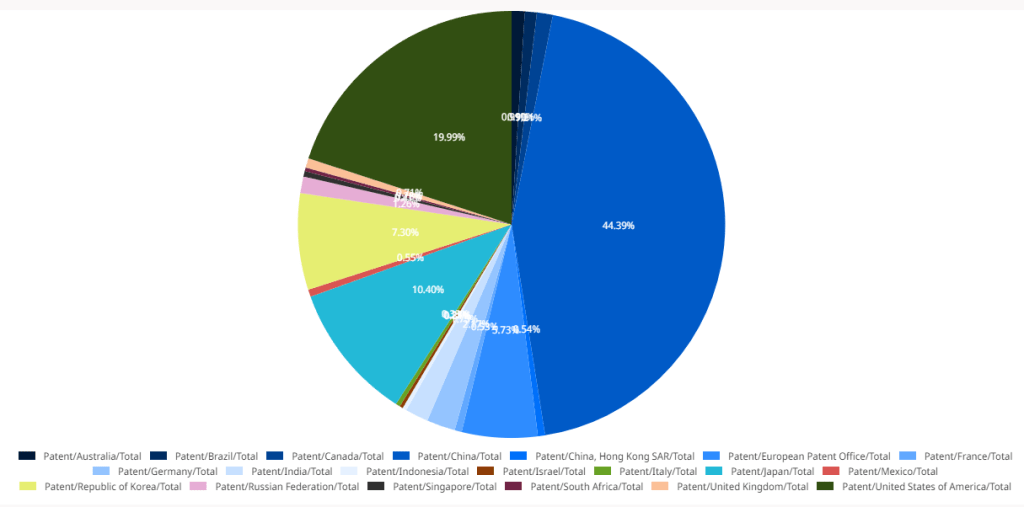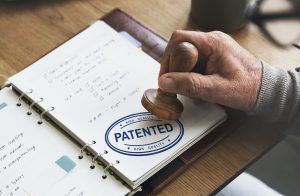The economy can enhance innovation and drive development. Intellectual property protection is crucial when entering overseas markets. Take patent applications in China, for example: According to the World Intellectual Property Report 2024, China has led the number of patent filings since 2011. Among the top 20 offices, Chinese patent applications account for 44.39%. Investors with valuable patent technologies are advised to apply for patents in China.
Figure 1: Patent – Applications for the top 20 offices 2023

Source: WIPO IP Statistics Data Center
To help entrepreneurs and investors protect their intellectual property in the country, here are some tips for business owners and inventors who need to file a patent.
1. Understand the Chinese Patent System
Overview of Different Types of Patents in China
a. Invention Patents: Cover new technical solutions or improvements to products or processes. For example, a novel pharmaceutical compound or a new manufacturing process.
b. Utility Model Patents: Protect new technical solutions related to the shape or structure of a product. These are typically quicker to obtain. For example, a new design for a mechanical component that enhances functionality.
c. Design Patents: Protect new designs concerning a product’s shape, pattern, or color combination. For example, an innovative aesthetic design for a smartphone that distinguishes it from competitors.
Key Differences between the Chinese Patent System and Other Countries
The Chinese patent system has unique aspects, such as the shorter examination period for utility models and the requirement for dual filing to benefit from both invention and utility model protection. Understanding these differences is crucial for a successful application.
Invention patents require a thorough examination of novelty, inventiveness, and applicability, unlike utility models and design patents, which do not undergo substantive examination.
Applications must be submitted in Chinese, which can pose translation challenges that affect the clarity and precision of technical terms. Accurate translation is crucial to avoid misunderstandings and ensure the patent application reflects the original invention correctly.
2. Preparing a Strong Application
Drafting the Patent Application in Chinese and Ensuring High-Quality Translation
a. Professional Translation: Use professional translators with technical expertise to ensure accuracy. The description must be thoroughly disclosed, and the claims should encompass a wide range of protection scopes, from broad to narrow, using standard, clear terms to define technical features. Additionally, the description must support the claims.
b. Cultural Sensitivity: Consider cultural nuances that might affect the interpretation of your invention. For example, technical terms may have different connotations in Chinese.
Detailed and Precise Description of the Invention, Including Claims and Drawings
Make sure your application includes a comprehensive description of the invention, clear and precise claims, and detailed drawings. This will help the examiners understand and assess the novelty and inventiveness of your patent.
3. Navigating the Examination Process
Steps Involved in the Patent Examination Process in China
a. Preliminary Examination: This checks for formal requirements and the completeness of the application.
b. Substantive Examination: For invention patents, this assesses novelty, inventiveness, and industrial applicability. The examiner will review prior art and determine whether the invention meets the necessary criteria.
Strategies for Expediting the Examination Process
a. Prioritized Examination: Request prioritized examination if your invention falls into certain categories, such as environmentally friendly technologies. This can accelerate the review process.
b. Early Submission: File your application as soon as possible to secure an earlier examination date. Early filing can also help in securing priority over similar inventions.
4. Protecting and Enforcing Your Patent
Post-Grant Procedures and Maintaining Patent Rights
After your patent is granted, comply with post-grant procedures such as paying maintenance fees to keep your patent in force. Regularly check for any changes in regulations that might affect your patent rights.
Effective Strategies for Monitoring and Enforcing Patent Rights in China
Monitor the market for potential infringements. Use local enforcement mechanisms, such as administrative actions or civil litigation, to protect your patent rights.
Understanding the Legal Landscape and Handling Infringement Cases
Familiarize yourself with the legal environment in China. Work with local legal experts to navigate the complexities of handling infringement cases and enforcing your rights effectively. Engage local legal experts to navigate the complexities of Chinese patent law. Local attorneys can provide valuable insights and support in handling infringement cases.
5. Utilizing Local Expertise and Resources
Importance of Partnering with Local Agents and Attorneys a. Local Knowledge: Benefit from their understanding of local procedures and regulations. Local agents and attorneys can provide insights into the nuances of the Chinese patent system.
b. Efficient Communication: Use their expertise to ensure clear and effective communication with CNIPA. This can help avoid misunderstandings and ensure the smooth processing of your application.
You could take advantage of resources from local organizations. Professional language service providers and patent agencies can offer guidance, updates, and assistance to help you complete your patent application smoothly.
Conclusion
By understanding the Chinese patent system, preparing a strong application, navigating the examination process, protecting your patent, and utilizing local expertise, you can improve your chances of successfully obtaining and enforcing a patent in China.
If you’re thinking about filing a patent in China and need guidance, get in touch with us.





